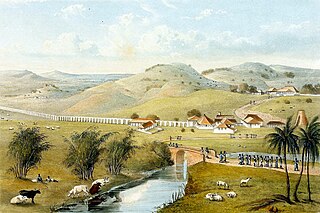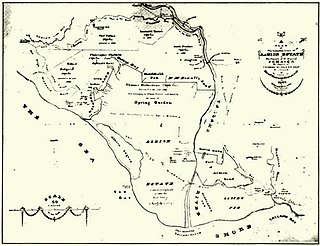
The Danish West Indies or Danish Antilles or Danish Virgin Islands was a Danish colony in the Caribbean, consisting of the islands of Saint Thomas with 32 square miles (83 km2); Saint John with 19 square miles (49 km2); Saint Croix with 84 square miles (220 km2), and Water Island with 491.5 acres (1.989 km2). The islands have belonged to the United States since they were purchased in 1917.

The Baptist War, also known as the Sam Sharpe Rebellion, the Christmas Rebellion, the Christmas Uprising and the Great Jamaican Slave Revolt of 1831–32, was an eleven-day rebellion that started on 25 December 1831 and involved up to 60,000 of the 300,000 slaves in Jamaica. The uprising was led by a black Baptist deacon, Samuel Sharpe and waged largely by his followers.

Samuel Sharpe, or Sharp, also known as Sam Sharpe, was an enslaved Jamaican man who was the leader of the widespread 1832 Baptist War slave rebellion in Jamaica.

Codrington College is an Anglican theological college in St. John, Barbados now affiliated with the University of the West Indies at Cave Hill. It is the oldest Anglican theological college in the Americas. It was affiliated to the University of Durham from 1875.

Slavery in the British and French Caribbean refers to slavery in the parts of the Caribbean dominated by France or the British Empire.

Bussa's rebellion was the largest slave revolt in Barbadian history. The rebellion takes its name from the African-born slave, Bussa, who led the rebellion which was defeated by British forces. Bussa's Rebellion was the first of three large-scale slave rebellions in the British West Indies that shook public faith in slavery in the years leading up to the abolition of slavery in the British Empire and emancipation of former slaves. It was followed by the large-scale rebellion in Demerara in 1823 and by an even larger rebellion in Jamaica in 1831–32. Collectively these are often referred to as the "late slave rebellions".

Sir John Gladstone of Fasque, 1st Baronet, FRSE LLD was a Scottish merchant, slave owner, Member of Parliament, and the father of the British Prime Minister William Ewart Gladstone. Through his commercial activities he acquired several large plantations in Jamaica and Guyana, worked initially by enslaved Africans. A massive slave revolt centred on his estates was brutally crushed by the military. The extent of his ownership of slaves was such that after slavery was abolished in 1833, he received the largest of all compensation payments made by the Slave Compensation Commission. After the passage of the Slavery Abolition Act 1833, Gladstone expelled most African workers from his estates and imported large numbers of indebted Indian indentured-servants, through false promises of providing them schools and medical attention. However, upon arrival they were paid no wages, the repayment of their debts being deemed sufficient, and worked under conditions that continued to resemble slavery in everything except name.
Thomas Thistlewood was a British citizen who migrated to the western end of the Colony of Jamaica where he became a plantation overseer and owner of land, property, and slaves. His diary is considered an important historical document chronicling the history of Jamaica and slavery during the 18th century. He is also known for keeping a detailed account of the treatments of his slaves as well as his sexual relationships with them.
The Second Maroon War of 1795–1796 was an eight-month conflict between the Maroons of Cudjoe's Town, a maroon settlement later re-named after Governor Edward Trelawny at the end of First Maroon War, located near Trelawny Parish, Jamaica in the St James Parish, and the British colonials who controlled the island. The Windward communities of Jamaican Maroons remained neutral during this rebellion and their treaty with the British still remains in force. Accompong Town, however, sided with the colonial militias, and fought against Trelawny Town.

Charles Rose Ellis, 1st Baron Seaford was a British politician.

Jamaica was an English colony from 1655 or 1670, and a British Colony from 1707 until 1962, when it became independent. Jamaica became a Crown colony in 1866.

Sir John Wedderburn of Ballindean, 6th Baronet of Blackness (1729–1803) was a Scottish landowner who made a fortune in slave sugar in the West Indies. Born into a family of impoverished Perthshire gentry, his father Sir John Wedderburn, 5th Baronet of Blackness, was executed for treason following the Jacobite uprising of 1745, and the young Wedderburn was forced to flee to the West Indies, where he eventually became the largest landowner in Jamaica. In 1769 he returned to Scotland with a slave, one Joseph Knight, who was inspired by Somersett's Case, a judgement in London determining that slavery did not exist under English law. Wedderburn was sued by Knight in a freedom suit, and lost his case, establishing the principle that Scots law would not uphold the institution of slavery either. Wedderburn ended his days as a wealthy country gentleman, having restored his family fortune and recovered the title Baronet of Blackness.
Dr John Drummond FRSE (1744–1804) was a British landowner, physician and surgeon associated strongly with Jamaican history. He appears to have had a liberal attitude toward the institute of marriage, with at least five families in Britain and Jamaica. Most documents refer to him simply as John Drummond of Jamaica.

The planter class, known alternatively in the United States as the Southern aristocracy, was a socio-economic caste of Pan-American society that dominated 17th- and 18th-century agricultural markets through the slavery of African Americans. The Atlantic slave trade permitted planters access to inexpensive labor for the planting and harvesting of crops such as tobacco, cotton, indigo, coffee, tea, cocoa, sugar cane, sisal, oil seeds, oil palms, hemp, rubber trees, and fruits. Planters were considered part of the American gentry.

Trinity was a plantation in colonial Jamaica, located south of Port Maria, in Saint Mary Parish, one of several plantations owned by Zachary Bayly that formed part of the area known as Bayly's Vale. By the early nineteenth century, over 1,000 people were enslaved there producing mainly sugar and rum for which a mile-long aqueduct was built by Nathaniel Bayly to supply water for the refining process.

Albion was a sugar plantation in Saint David Parish, Jamaica. Created during or before the 18th century, it had at least 451 slaves when slavery was abolished in the British Empire in 1833. By the end of the 19th-century it was the most productive plantation in Jamaica due to the advanced refining technology it used. By the early 20th century, however, its cane sugar could not compete with cheaper European beet sugar, and it produced its last sugar crop in 1928. It subsequently became a banana farm for the United Fruit Company.

Edward McGeachy was the Crown Surveyor for the county of Surrey in Jamaica. He trained Thomas Harrison, the first Government Surveyor of Jamaica. He owned Bull Park plantation and Brighton Pen in Saint David Parish and in 1837 received compensation for the loss of eight slaves following the abolition of slavery in the British Empire in 1833.
Alexander Bravo, sometimes spelled Alexandre Bravo, was a Jamaican-born Sephardic Jewish merchant, politician, slave plantation owner and Auditor-General of Jamaica. Bravo was the first Jew person to be elected to the House of Assembly of Jamaica.















